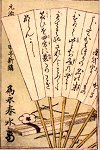| Satsuma
Rebellion
The first test of the young Meiji government came
with the revolt of the powerful Satsuma clan based in the southern
region of the island of Kyushu. This influential clan was headed
by the Shimazu family, which had been founded by Shimazu Tadahisa,
son of Minamoto Yoritomo, in the Kamakura period. It was one of
the two powerful clans (the other was the Choshu) that made the
restoration of power to the Emperor possible. After nine years of
working close to the central government, the samurai of Satsuma
had grown dissatisfied with the direction the government was taking.
They organized a considerable army to fight against the untried
troops of the central government. It was a momentous clash between
traditional Japanese warfare, as waged by the sword-wielding individual
warriors, and the new peasant army, trained in western strategy
and using western weapons. The rebellion was led by Saigo Takamori,
a giant of a man with an engaging personality who, just a few years
earlier, had been a leader in the government and who, as field marshall,
had actually been responsible for forming the government army that
he now opposed. Saigo was one of the three young samurai who had
joined the government and whose personal magnetism had helped to
weld it together. The second was Kido Koin,a samurai from the Choshu
clan, who was an extraordinarily able diplomat, a master of the
art of persuasion. Kido's historical importance rests primarily
upon his conviction that feudalism had to be abolished if the nation
was to prosper together with his ability to convince the feudal
lords that it was in their own interests, as well as their patriotic
duty, to return the Emperor to power and to support the new central
government. The third of the triumvirate was Okubo Toshimichi who,
as Saigo, was also a member of the Satsuma clan. Saigo was the impetuous
man of action, Kido the diplomat, and Okubo the master planner of
the new regime. Later it was because of the opposition of Okubo
to Saigo 's ideas for conquest and expansion that Saigo resigned
from the government. Saigo had advanced a plan for the conquest
of Korea that included sending an envoy to that country to make
impossible and insulting demands. This would result, he explained,
in the Koreans executing the envoy and would thereby give Japan
an excuse for declaring war. The envoy, he insisted, would be himself.
Okubo and Kido refused him, and Saigo went back to his home in Kyushu.
There, he was prevailed upon to join the rebellious samurai and
to lead them against the government army. The government acted swiftly
to crush the rebellion. The fighting was brief but bloody. Saigo
and his men fought well, but the government soldiers easily triumphed.
When he was badly wounded, he committed suicide in the samurai tradition,
rather than be captured. But his contribution to the early government,
his bravery and spirit were not forgotten. He became a hero to future
Japanese soldiers and was pardoned posthumously by the Meiji Emperor,
whom he had both supported and opposed.

|







